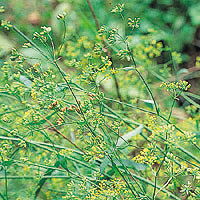Bupleurum
 © Martin Wall
© Martin WallHow It Works
Bupleurum contains constituents known as saikosaponins that appear to account for much of the medicinal activity of the plant. Test tube studies have shown that the sho-saiko-to combination can increase production of various chemicals (known as cytokines) that immune cells use to signal one another.3 Test tube studies have also found that saikosaponins can inhibit growth of liver cancer cells,4 and are anti-inflammatory.5, 6
Human trials, only one double-blind, have shown that the bupleurum-containing formula sho-saiko-to may help reduce symptoms and blood liver enzyme levels in children and adults with chronic active viral hepatitis.7, 8, 9, 10 Most of these studies were in people with hepatitis B infection, though one preliminary human trial has also shown a benefit in people with hepatitis C.11 Sho-saiko-to was also found, in a large, preliminary (but not double-blind), study to decrease the risk of people with chronic viral hepatitis developing liver cancer.12
Sho-saiko-to has also been used to reduce symptoms of and possibly decrease the severity of liver cirrhosis, though clinical studies on this condition are generally lacking. One randomised trial (it was unclear if this trial was double-blind) found that sho-saiko-to could reduce the rate of liver cancer in people with liver cirrhosis.13
A few uncontrolled trials in Japan have shown that sho-saiko-to or very similar traditional Japanese and Chinese herbal formulas (all containing bupleurum) can reduce seizure frequency and/or severity in people with epilepsy that does not respond to anti-seizure medications.14, 15, 16, 17 However, double-blind trials are still needed to determine the importance of these findings.
Sho-saiko-to has been found to inhibit human immunodeficiency virus (HIV) in the test tube.18 Yet, it is unclear to what degree bupleurum or saikosaponins contributed to this effect. Sho-saiko-to also increased the efficacy of the standard anti-HIV drug lamivudine in the test tube.19 Human data are lacking on the benefit of sho-saiko-to or bupleurum in people with HIV infection or acquired immunodeficiency syndrome (AIDS).
How to Use It
Generally 500–2,000 mg bupleurum dry root are taken three times daily in capsules.20 Traditionally, and in some clinical studies, bupleurum was prepared as a tea in which the root is decocted or cooked for hours before use. Some people take 1–4 grams per cup of water, three times daily. Sho-saiko-to formula is typically given in capsules (1.8–2.5 grams) three times per day. The amount given to children should be proportionally reduced based on individual weight and height as compared to adults.21
Copyright © 2024 TraceGains, Inc. All rights reserved.
Learn more about TraceGains, the company.
The information presented by TraceGains is for informational purposes only. It is based on scientific studies (human, animal, or in vitro), clinical experience, or traditional usage as cited in each article. The results reported may not necessarily occur in all individuals. Self-treatment is not recommended for life-threatening conditions that require medical treatment under a doctor's care. For many of the conditions discussed, treatment with prescription or over the counter medication is also available. Consult your doctor, practitioner, and/or pharmacist for any health problem and before using any supplements or before making any changes in prescribed medications. Information expires December 2024.



 We are proud to announce that
We are proud to announce that  As the market evolves, customers increasingly request a wider variety of omega-3 options for their lipid...
As the market evolves, customers increasingly request a wider variety of omega-3 options for their lipid...  Maintaining healthy glucose levels is crucial for preventing metabolic conditions like diabetes,...
Maintaining healthy glucose levels is crucial for preventing metabolic conditions like diabetes,...  Looking at formulating a new vitamin blend? Discover
Looking at formulating a new vitamin blend? Discover 







































